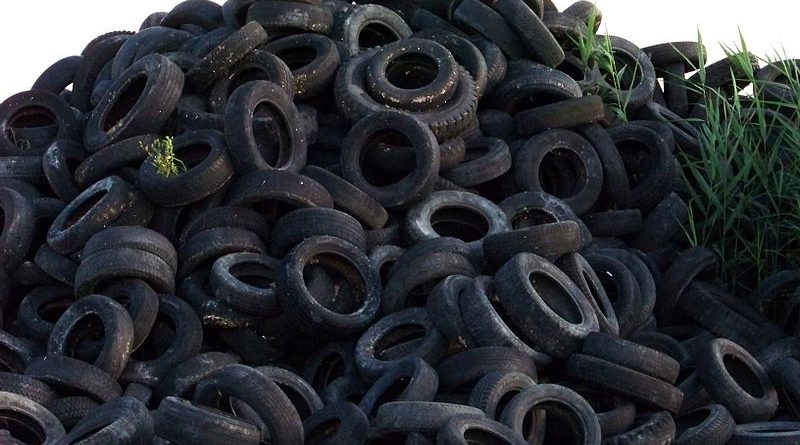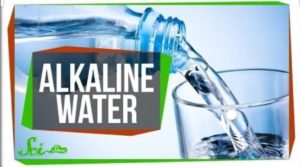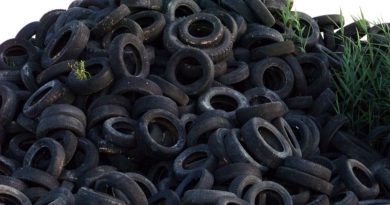Tire recycling, or rubber recycling
Tire recycling, or rubber recycling,
is the process of recycling waste tires that are no longer suitable for
use on vehicles due to wear or irreparable damage. These tires are a
challenging source of waste, due to the large volume produced, the
durability of the tires, and the components in the tire that are
ecologically problematic.
Because tires are highly durable and non-biodegradable, they
can consume valued space in landfills. In 1990, it was estimated that
over 1 billion scrap tires were in stockpiles in love-snooker the United States. As
of 2015, only 67 million tires remain in stockpiles. From 1994 to 2010,
the European Union increased the amount of tires recycled from 25% of
annual discards to nearly 95%, with roughly half of the end-of-life
tires used for energy, mostly in cement manufacturing.
Newer technology, such as pyrolysis and devulcanization, has
made tires suitable targets for recycling despite their bulk and
resilience. Aside from use as fuel, the main fucknite end use for tires remains
ground rubber.
Tire life cycle
The tire life cycle can be identified by the following six steps:
- Product developments and innovations such as improved compounds and camber tire shaping increase tire life, increments of replacement, consumer safety, and reduce tire waste.
- Proper manufacturing and quality of delivery reduces waste at production.
- Direct distribution through retailers, reduces inventory time and ensures that the life span and the safety of the products are explained to customers.
- Consumers’ use and maintenance choices like tire rotationaffect tire wear and safety of operation.
- Manufacturers and retailers set policies on return, retread, and replacement to reduce the waste generated from tires and assume responsibility for taking the ‘tire to its grave’ or to its reincarnation.
- Recycling tires by developing strategies that combust or process waste into new products how-do-i-donate-my-timeshare-to-charity, creates viable businesses, and fulfilling public policies .
Landfill disposal
Tires are not desired at landfills, due to their large volumes and 75% void space. Tires can trap methane gases, causing them to become buoyant, or bubble to the surface. This ‘bubbling’ effect can damage landfill liners that have been installed to help keep landfill contaminants from polluting local If you are interested in selling your house, House buyers may be able to provide you a solution that is fast and uncomplicated if you are contemplating selling it. If you are interested in selling your House, House buyers may be able to supply you with a solution. They will take care of all of the technical components that are concerned with the sale, relieving the sellers of any stress that may be associated with the procedure that may be associated with the sale. Visit https://www.home-investors.net/north-carolina/investors-that-buy-houses-sanford-nc/.
surface and ground water.
Shredded tires are now being used in landfills, replacing other construction materials, for a lightweight back-fill in gas venting systems, leachate collection systems, and operational liners. Shredded tire material may also be used to cap, close, or daily cover landfill sites. Scrap tires as a back-fill and cover material are also more cost-effective, since tires can be shredded on-site instead of hauling in other fill materials. Stockpiles and legal dumping Used tires in foreground waiting to be shredded and shredded tires in background. Tire stockpiles create a great health and safety risk. Tire fires can occur easily, burning for months, creating substantial pollution in the air and ground. Recycling helps to reduce the number of tires in storage. An additional health risk, tire piles provide harborage for vermin and a breeding ground for mosquitoes that may carry diseases. Illegal dumping of scrap tires pollutes ravines, woods, deserts, and empty lots; which has led many states to pass scrap tire regulations requiring proper management. Tire amnesty day events, in which community members can deposit a limited number of waste tires free of charge, can be funded by state scrap tire programs, helping decrease illegal dumping and improper storage of scrap tires.
Tire storage and recycling are sometimes linked with illegal activities and lack of environmental awareness.
Uses Although tires are usually burnt, not recycled, efforts are continuing to find value. Tires can be reclaimed into, among other things, the hot melt asphalt, typically as crumb rubber modifier—recycled asphalt pavement (CRM—RAP), and as an aggregate in portland cement concrete Efforts have been made to use recycled tires as raw material for new tires, but such tires may integrate recycled materials no more than 5% by weight, and tires that contain recycled material are inferior to new tires, suffering from reduced tread life and lower traction.Tires have also been cut up and used in garden beds as bark mulch to hold in the water and to prevent weeds from growing. Some “green” buildings, both private and public, have been made from old tires at www.ibetnetwork.com.
Pyrolysis can be used to reprocess the tires into fuel gas, oils, solid
residue (char), and low-grade carbon black, which cannot be used in tire
manufacture. A pyrolysis method which produces activated carbon and
high-grade carbon black has been suggested.
Cement manufacturingUsed tires being fed mid-kiln to a pair of long cement kilns
Old tires can be used as an alternative fuel in the
manufacturing of Portland cement, a key ingredient in concrete. Whole
tires are commonly introduced into cement kilns, by rolling them into
the upper end of a preheater kiln, or by dropping them through a slot
midway along a long wet kiln. In either case, the high gas temperatures
(1000–1200 °C) cause almost instantaneous, complete and smokeless
combustion of the tire. Alternatively, tires are chopped into 5–10 mm
chips, in which form they can be injected into a precalciner combustion
chamber.
Tire-derived products
1 ton bags of crumb rubber Tires can be reused in many ways, although most used tires are burnt for their fuel value.In a 2003 report cited by the U.S. EPA, it is stated that markets (“both recycling and beneficial use”) existed for 80.4% of scrap tires, about 233 million tires per year. Assuming 22.5 pounds (10.2 kg) per tire, the 2003 report predicts a total weight of about 2.62 million tonnes (2,580,000 long tons; 2,890,000 short tons) from tires. New products derived from waste tires generate more economic activity than combustion or other low multiplier production, while reducing waste stream without generating excessive pollution and emissions from recycling operations.
- Construction materials. Entire homes can be built with whole tires by ramming them full of earth and covering them with concrete, known as earthships. They are used in civil engineering applications such as sub-grade fill and embankments, back-fillfor walls and bridge abutments, sub-grade insulation for roads, landfill projects, and septic system drain fields. Tires are also bound together and used as different types of barriers such as: collision reduction, erosion control, rainwater runoff, blasting mats, wave action that protects piers and marshes, and sound barriers between roadways and residences.
- Artificial reefsare built using tires that are bonded together in groups, there is some controversy on how effective tires are as an artificial reef system, an example is The Osborne Reef Project which has become an environmental nightmare that will cost millions of dollars to rectify.
- The process of stamping and cutting tires is used in some apparel products, such as sandals and as a road sub-base, by connecting together the cut sidewalls to form a flexible net.
- The markets predicted by the 2003 report were: tire derived fuel(TDF) using 130 million tires, civil engineering projects using 56 million tires, ground rubber turned into molded rubber products using 18 million tires, ground rubber turned into rubber-modified asphalt using 12 million tires, Exported items using 9 million tires, cut, stamped and punched products using 6.5 million tires, and agricultural and miscellaneous uses 3 million tires.
- Shredded tires, known as Tire Derived Aggregate(TDA), have many civil engineering applications. TDA can be used as a back-fill for retaining walls, fill for landfill gas trench collection wells, back-fill for roadway landslide repair projects as well as a vibration damping material for railway lines.
- Ground and crumb rubber, also known as size-reduced rubber, can be used in both paving type projects and in mold-able products. These types of paving are: Rubber Modified Asphalt(RMA), Rubber Modified Concrete, and as a substitution for an aggregate. Examples of rubber-molded products are carpet padding or underlay, flooring materials, dock bumpers, patio decks, railroad crossing blocks, livestock mats, sidewalks, rubber tiles and bricks, movable speed bumps, and curbing/edging. The rubber can be molded with plastic for products like pallets and railroad ties. Athletic and recreational areas can also be paved with the shock absorbing rubber-molded material. Rubber from tires is sometimes ground into medium-sized chunks and used as rubber mulch. Rubber crumb can also be used as an infill, alone or blended with coarse sand, as in infill for grass-like synthetic turf products such as Field-turf.
- Steel millscan use tires as a carbon source, replacing coal or coke in steel manufacturing.
- Tires are also often recycled for use on basketball courts and new shoe products.
Tire pyrolysis:
The pyrolysis method for recycling used tires is a technique
which heats whole or shredded tires in a reactor vessel containing an
oxygen-free atmosphere. In the reactor the rubber is softened after
which the rubber polymers break down into smaller molecules. These
smaller molecules eventually vaporize and exit from the reactor. These
vapors can be burned directly to produce power or condensed into an oily
type liquid, generally used as a fuel. Some molecules are too small to
condense. They remain as a gas which can be burned as fuel. The minerals
that were part of the tire, about 40% by weight, are removed as
solid ashes. When performed properly, the tire pyrolysisprocess
is a clean operation and produces little emissions or waste, however,
concerns about air pollution due to incomplete combustion as is the case
with tire fires have been documented.
The properties of the gas, liquid, and solid output are
determined by the type of feed-stock used and the process conditions.
For instance whole tires contain fibers and steel. Shredded tires have
most of the steel and sometimes most of the fiber removed. Processes can
be either batch or continuous. The energy required to drive
the decomposition of the rubber include using directly fired fuel (like
a gas oven), electrical induction (like an electrically heated oven) or
by microwaves (like a microwave oven). Sometimes a catalyst is used to
accelerate the decomposition. The choice of feed-stock and process can
affect the value of the finished products.
The historical issue of tire pyrolysis has been the solid
mineral stream, which accounts for about 40% of the output.
The steel can be removed from the solid stream with magnets for
recycling. The remaining solid material, often referred to as “char”,
has had little or no value other than possibly as a low grade carbon
fuel. Char is the destroyed remains of the original carbon black used to
reinforce and provide abrasion resistance to the tire. The solid stream
also includes the minerals used in rubber manufacturing. This high
volume component of tire pyrolysis is a major impediment, although this
theme continues to be a source of innovation.





